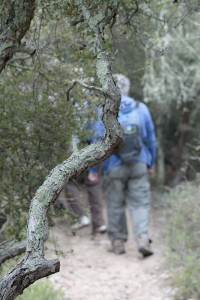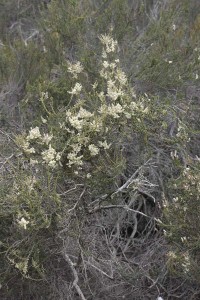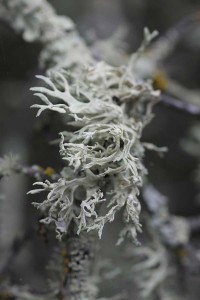The morning opened overcast, foggy, even. You couldn’t ask for a more appropriate day to visit the mysteries of the area the locals call The Tunnels. The location is currently closed to public access until a plan for trails and managmenet is finalized, but I got to tag along on a trip organized by the local California Native Plant Society chapter.
To get to the tunnels you pass a mesa top with blooming chamise, Adenostoma fasciculatum.
More blooming chamise. It’s a signature plant of this chaparral habitat.

Disappearing into the trees: This is the fun-slash-magic part of visiting The Tunnels.
The scrub oak scrub deep in The Tunnels is made up of Quercus dumosa and Q. berberdifolia and towers over you–ten, fifteen feet, even more in spots. Trip leader Frank was calling this old-growth chaparral, an environment so old and established that you can’t tell its age, meaning this area hasn’t burned intensely in many decades or even centuries. In old-growth chaparral you’ll find plants of all ages and stages of life, not just a uniform cohort of seedlings starting over after a fire. Seeing how rich this area is, you can begin to understand how big a lie it is when people insist that fire is essential to maintaining the health environments like this.
Acorns on the scrub oaks.
And before you get acorns the oaks must bloom…
Inside the Hobbit World. Giant scrub oak branches overhead, lots of it with lichen attached.
Did someone say “lichen?”
More branches with lichen.
Even more lichen, close up. I never get tired looking at the stuff.
No Hobbits so far, but wood rats had set up this nest overhead. Strange. They usually nest closer to the ground.
Below there was a diverse understory of plants, rare or common or weedy. This is the common wood fern, Dryopteris arguta.
In the weedy category is this new annoying non-native, bur chervil, Anthriscus caucalis.
One of the cooler understory plants, miner’s lettuce. The species here is Claytonia parviflora.
Toxicoscordon fremontii sounds like a scary plant–so does one of its common names of Death Camas–perfect for this netherworld. Yes, the plant, particularly the bulb, is poisonous.
The buds of Fremont’s star lily. Actually it’s the same species as the death camas I just showed you, only this is its prettier name.
Melic grass, Melica imperfecta, thriving in the shade of The Tunnels.
Another of the understory plants here: early onion, Allium praecox.
Another understoy plant: western dichondra, Dichondra occidentalis. I get dichondra popping up in my garden at home. At first I got excited since D. occidentalisis a rare plant. But then I realized he plant in my garden was a relic of the dichondra species (D. micrantha) used as a lawn substitute in the well-watered suburbia of days gone by.
Yet another denizen of the shade, the pretty prolific and common Eucrypta chrysanthemifolia.
So… what other wonders do you think you’ll find in this magical underground world? How about an abandoned pot farm?
Actually, when I look at this hillside, I don’t really see a pot farm, but I’m assured that there used to be one here. There are little telltale signs, like little basins dug into the slope to retain moisture.
On the way out, back on the mesa top you see sights like this: branches of the chamise, with golden yarrow (Eriophyllum confertiflorum) blooming inside them.
Also up on the mesa is this, Adolphia californica, a plant listed as endangered in California, though it’s common elsewhere (Mexico). San Diego County is the only place in California that you’ll find it.
Mine was a group of people dedicated to leaving a place as pristine or even more so than when you experienced it. Here’s one of the bags people had going of assorted artifacts left by previous visitors (and inhabitants, apparently). Shoes, bottles, wrappers–nothing transcendentally weird this time.

























Old growth chaparral, not burnt. Interesting, now I wonder about ‘old growth’ fynbos. An idea to look for, in the literature and when hiking.
‘The Tunnels’ is an evocative name; they should probably keep it somehow when the place gets more public visitation. Chamise chaparral is one plant community that I sometimes have trouble appreciating as much as I should, but with the tall scrub oaks and all those understory plants, it sounds like a great spot.
This is enchanting!
I just planted some Claytonia in my garden to use in salads, soups, and smoothies, but it’s a different species. I have it in rich soil, and it’s doing best in semi-shade–very different from chapparal!
EE, fynbos and fire seem to be wedded in discussions I’ve ready. I know you’ve commented about human-origin fires in the past, and I wonder if fynbos burns are much more common because of the human vector. And I wonder if the ecosystem would be different–and richer–if it didn’t burn as much or at all.
Ryan, the mesa-top chamise chaparral is a lot less varied than what you find on the slopes inside the tunnels. It definitely doesn’t push the same buttons as life in the Tunnels, where there’s a great sense of shelter.
Kristin, I’ve had C. perfoliata in my garden and in my salads. Cool plant–and delicious too! (Not to mention it looks like no other salad green out in the stores.)
I’m likin’ the lichen. I went to some trouble to find seeds and plant miner’s lettuce, then found it growing right along our road, more happily than in the garden.
This is a very different ecosystem than any I have encountered personally…enjoyed the tour.
Today this came up in my reader.
http://bluehillescape.blogspot.com/2012/04/fin.html
‘I also remember the sadness I felt looking across from the Swartberg to the Kammanassie and watching clouds of smoke rising from where I had been only a few days before, knowing that the beautiful mature fynbos and all its birds were no more’.
Researching the effect on fynbos birds of climate change.